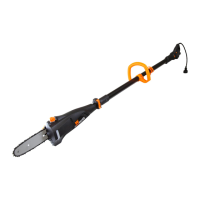11
OPERATION
SAFETY WARNINGS
1. In order to ensure safe work, do not operate the saw at an angle of over 60°.
2. Never stand below a branch that is being sawed.
3. Exercise caution when sawing both branches under tension or branches that are splintering.
4. Make sure to safe guard against the risk of injury from falling branches and flying wood projectiles.
5. If the machine is in operation, keep persons and animals away from the danger area.
6. The machine is not protected against electric shock when coming into contact with high-voltage lines. Maintain
a minimum clearance of 30 feet from current-carrying powerlines to avoid life-threatening electric shock.
7. When working on an incline, always stand above or to the side of the branch being sawed. Hold the machine as
close as possible to your body. By doing so, you maximize your balance.
SAWING TECHNIQUES
When removing branches, hold the pole saw at an angle ranging from 0 to 60° in order to avoid being struck by a
falling branch. The saw should never be operated directly above head.
Saw off the lower branches on the tree first. By doing so, it is easier for the cut branches to fall to the ground.
At the end of the cut, the weight of the saw suddenly increases for the user since it is no longer being supported by
a branch. There is a risk of losing control of the saw, so make sure to stay alert during the entire sawing operation.
Only pull the saw out of a cut while the saw is running. By doing so, you prevent the chain from jamming in the
wood.
Do not saw with the tip of the guide bar. Do not saw into the branch formations (where the tree branches out-
wards). This will impede the tree’s ability to reheal.
For sawing off smaller branches, place the stop face of the saw on the branch. This prevents unwanted movements
of the saw at the beginnging of the cut. While applying light pressure, guide the saw through the branch from top
to bottom.
For sawing off larger branches, first make a relief cut. Saw through 1/3 of the branch diameter from the bottom to
top using the top side of the guide bar. Then saw from top to bottom for the other 2/3 using the bottom side of
the guide bar. Saw off longer branches in sections in order to maintain control over the location of impact.
PREVENTING KICKBACK
The term kickback refers to when the saw suddenly jumps up and back. This is usually caused by the workpiece
coming into contact with the guide bar tip or the clamping of the saw chain.
A kickback generates an abrupt powerful force. The saw usually reacts in an uncontrolled manner, creating the
possibiilty of injury to the user.
The danger of a kickback is greatest if you apply the area near the guide bar tip into a branch. Always apply the
saw as flatly as possible in order avoid a loss of control during operation.

